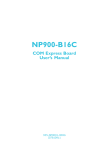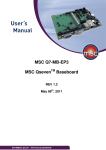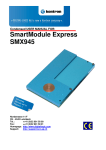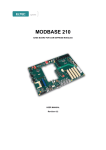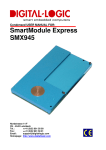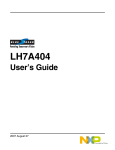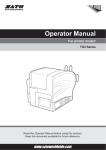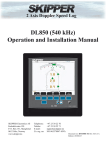Download Compaq COM Express Extension User's Manual
Transcript
COM Express™ Extension Specification Rev. 013 This page intentionally left blank Table of Contents Table of Contents 1 User Information......................................................................................................................... 5 1.1 1.2 1.3 1.4 2 Introduction................................................................................................................................. 6 2.1 2.2 2.3 2.4 3 About This Document...................................................................................................... 5 Copyright Notice ............................................................................................................. 5 Technical Support............................................................................................................ 5 Disclaimer........................................................................................................................ 5 COM Express™ Extension Specification ......................................................................... 6 COM Express™ Design Guide ......................................................................................... 6 COM Express™ Computer-On-Module ........................................................................... 6 Objective.......................................................................................................................... 8 COM Express™ Module sizes ..................................................................................................... 9 3.1 3.1.1 3.1.2 Overview - Module Size .................................................................................................. 9 Figure - Overview – three module sizes ........................................................................ 10 Small Form Factor nano, COM Express™ Type 1........................................................ 10 Figure 3 – Small Form Factor nano ............................................................................................. 11 4 Signal Description ..................................................................................................................... 12 4.1 4.1.1 4.1.2 5 Graphic Signal Description............................................................................................ 12 Table – Graphic Signal Description - Row C for Pin-out Type 2 ................................. 12 Table – Graphic Signal Description - Row D for Pin-out Type 2 ................................. 13 Hardware extensions................................................................................................................. 15 5.1 5.1.1 5.2 5.2.1 Wide Range Input Power............................................................................................... 15 Wide Range Input Power for nano SFF......................................................................... 15 GPIO General Purpose I/O Recommended Use ............................................................ 16 Alternative GPIO use for SDIO Interface...................................................................... 17 SDIO Pin description ....................................................................................................................... 17 5.3 6 Thermal Control............................................................................................................. 18 Software extensions................................................................................................................... 19 6.1 6.2 6.3 6.4 6.4.1 TPM support .................................................................................................................. 19 Smart Battery BIOS support .......................................................................................... 19 Legacy Super I/O support in BIOS................................................................................ 20 CMOS backup in BIOS ................................................................................................. 20 Console redirection in BIOS.......................................................................................... 20 Copyright © COM Express™ Extension Specification Rev 012 iii Table of Contents 6.4.2 7 Apendix A: PC Architecture Information .............................................................................. 21 7.1 7.1.1 7.1.2 7.2 7.3 7.3.1 7.3.2 7.3.3 7.4 8 User editor for default settings....................................................................................... 20 Buses.............................................................................................................................. 21 ISA, Standard PS/2 – Connectors .................................................................................. 21 PCI 21 General PC Architecture................................................................................................ 21 Ports ............................................................................................................................... 22 RS-232 Serial................................................................................................................. 22 Serial ATA..................................................................................................................... 22 USB ............................................................................................................................... 22 Programming ................................................................................................................. 23 APPENDIX B: DOCUMENT-REVISION HISTORY.......................................................... 24 Copyright © COM Express™ Extension Specification Rev 012 iv 1 User Information 1 User Information 1.1 About This Document This document provides information about products from Kontron Embedded Modules GmbH, and/or its subsidiaries. No warranty of suitability, purpose, or fitness is implied. While every attempt has been made to ensure that the information in this document is accurate, the information contained within is supplied “as-is” and is subject to change without notice. For the circuits, descriptions and tables indicated, Kontron assumes no responsibility as far as patents or other rights of third parties are concerned. 1.2 Copyright Notice Copyright © 2007 - 2008 COM Express™ Extension Kontron Embedded Modules GmbH and Advantech Co., Ltd. are founding members of the COM Industrial Group the purpose of which is the definition, marketing and promotion of the COM Technologies. Kontron Embedded Modules GmbH and Advantech Co., Ltd. Have significantly contributed to the development and promotion of the COM Industrial Standard and administrates the COM Industrial Group’s website (http://www.com-ig.org/). All rights reserved. No part of this document may be reproduced, transmitted, transcribed, stored in a retrieval system, or translated into any language or computer language, in any form or by any means (electronic, mechanical, photocopying, recording, or otherwise), without the express written permission of COM Industrial Group founding Members. 1.3 Technical Support Technicians and engineers from COM Industrial Group Members are available for technical support. We are committed to making our product easy to use and will help you use our products in your systems. http://www.comexpress-extension.org/members/members.php Before contacting COM Industrial Group Members technical support, please consult our web site at http://www.comexpress-extension.org for the latest product documentation, utilities, and drivers. If the information does not help solve the problem, contact us by email. http://www.comexpress-extension.org/contact/contact.php 1.4 Disclaimer Although the information presented in this document was carefully reviewed and is believed to be accurate, it is not guaranteed. The reader assumes all liability for the use of the information herein. Copyright © COM Express™ Extension 5 Specification Rev 013 2 Introduction 2 Introduction 2.1 COM Express™ Extension Specification The COM Express™ Extension Specification builds on the COM Express™ (COM.0) standard as defined by the PCI Industrial Computer Manufacturers’ Group (PICMG®) which is an industry standard adopted for Computer-On-Modules. The COM Express™ Extension Specification is focused with its intellectual properties on the deep embedded market and is intended to be an add-on to the PICMG’s COM Express™ COM.0 Specification. It is the intention of the authors of this specification to propose the information contained here within to PICMG® as a means of updating the current COM Express™ standard to ensure continued saleability and compatibility of all COM Express™ solutions. 2.2 COM Express™ Extension Design Guide The COM Express™ Design Guide, a separate document from both the PICMG® COM Express™ Specification and this COM Express™ Extension Specification, is available to COM Express™ module customers upon request. For download the COM Express™ Extension Design guide please visit our web page: http://www.comexpress-extension.com/specs/specs.php The COM Express™ Design Guide explores the requirements of the COM Express™ Extension Specification and provides recommendations on designing COM Express™ baseboards to support various features of COM Express™ compliant modules. The COM Express™ Design Guide, based upon the COM Express™ Extension Specification and PICMG® COM Express™ Specification, discusses capabilities in the specification with schematic examples where applicable and offers ideas to consider for maximum flexibility in designing baseboards. 2.3 COM Express™ Computer-On-Module A COM Express™ Computer-On-Module (COM) is a module with all components necessary for a bootable host computer, packaged as a super component. COMs require a carrier board in order to bring out I/O and to power up the CPU module. COMs are used to build single board computer solutions and offer OEMs fast time-to-market with reduced development cost. Like integrated circuits, they provide OEMs with significant freedom when working to meet form-fitfunction requirements. For all of these reasons, COM methodology has gained significant popularity with OEMs in the embedded industry. The COM Express™ standard is designed to be future proof and to provide a smooth transition path from legacy parallel interfaces to LVDS (Low Voltage Copyright © COM Express™ Extension 6 Specification Rev 013 2 Introduction Differential Signalling) interfaces. These include the PCI bus and parallel ATA on the one hand and PCI Express and Serial ATA on the other hand. Key features include: Rich complement of contemporary high bandwidth serial interfaces, including PCI Express, Serial ATA, USB 2.0, and Gigabit Ethernet 32-bit PCI, LPC and Parallel ATA options preserved for easy interface to a range of peripherals Extended power-management capabilities Robust thermal and mechanical concept Cost-effective design Legacy-free design (no Super I/O, PS2 keyboard or mouse) COM Express™ module size with two currently defined footprint options (“Basic” and “Extended”) to satisfy a range of performance requirements. The option for future more compact footprints like microETXexpress and nanoETXexpress are present. High-performance mezzanine connector with several defined pin-out types to satisfy a range of application requirements The COM Express™ Extension specification has been created to support to a range of vertical embedded markets. It has been formulated to be applicable to a broad range of system types, from floor-installed and bench-top to mobile handheld. Markets and applications include but are not limited to: Healthcare - clinical diagnostic imaging systems, patient bedside monitors, etc. Retail & advertising - electronic shopping carts, billboards, kiosks, POS/POI systems, etc. Gaming & entertainment - simulators, slot machines, etc. Test & measurement - scientific and industrial test and measurement instruments Industrial automation - industrial robots, vision systems, etc. Security - digital CCTV, luggage scanners, intrusion detectors, etc. Defence & government - unmanned vehicles, rugged laptops, wearable computers, etc. Systems developed according to the COM Express™ Extension Specification require the implementation of an application-specific carrier board that accepts the module. The carrier board is typically a 4- to 8-layer PCB. User-specific features such as external connector choices and locations and peripheral circuits can be tailored to suit the application. The OEM can focus on applicationCopyright © COM Express™ Extension 7 Specification Rev 013 2 Introduction specific features rather than caring for a CPU board design. The OEM also benefits from a wide choice of modules providing a scalable range of price and performance upgrade options. 2.4 Objective Consistent with the objective of the PICMG® COM Express™ Specification, the COM Express™ Extension specification defines COM Express™ compliant modules at a level of detail sufficient to allow interoperability between independent vendor modules and carrier boards. Copyright © COM Express™ Extension 8 Specification Rev 013 3 COM Express™ Module sizes 3 COM Express™ Module sizes 3.1 Overview - Module Size The primary difference between the current basic module and the extended module as well as future compact footprints like microETXexpress and nanoETXexpress is the over-all physical size and the performance envelope supported by each. The extended module offers larger real estate and can accommodate larger processor, chips and memory solutions which are not possible on the basic module. The extended module and the basic module use the same connectors and pin-outs and utilize several common mounting hole positions. This level of compatibility allows that a carrier board designed to accommodate an extended module can also support a basic module, microETXexpress or nanoETXexpress modules. This holds true for any future defined compact modules as they too will utilize the same connectors and pin-outs Up to 440 pins of connectivity are available between COM Express™ modules and the carrier board. Legacy buses such as PCI, parallel ATA, LPC, AC'97 can be supported as well as new high speed serial interconnects such as PCI Express, Serial ATA or SAS and Gigabit Ethernet. To enhance interoperability between COM Express™ modules and carrier boards, five common signalling configurations (Pin-out Types) have been defined to ease system integration. Some Pin-out Types definitions require only a single 220-pin connector, like nanoETXexpress and others require both 220pin connectors to supply all the defined signalling. Copyright © COM Express™ Extension 9 Specification Rev 013 3 COM Express™ Module sizes Figure - Overview – three module sizes All coordinates in mm. top view ( X1 is on bottom side, seen through pcb) 3.1.1 Small Form Factor nano, COM Express™ Type 1 Copyright © COM Express™ Extension 10 Specification Rev 013 3 COM Express™ Module sizes The PCB size for the nano module is defined as 55mm x 84mm. The holes shown in this drawing are intended for mounting the module / heat-spreader combination to the carrier board. An independent, implementation specific set of holes and spacers shall be used to attach the heat-spreader to the module. Figure - Small Form Factor nano 8 55 51 COM Express™ Type 1 4 4 80 Holes Compatible to COM Express™ ecification All dimensions are shown in millimetres. Tolerances should be ± 0.25mm [±0.010"], unless noted otherwise. The tolerances on the module connector locating peg holes (dimensions [16.50, 6.00]) should be ± 0.10mm [±0.004"]. The 220 pin connector shall be mounted on the backside of the PCB and is seen “through” the board in this view. The X mounting holes shown should use 6mm diameter pads and should have 2.7mm plated holes, for use with 2.5mm hardware. The pads should be tied to the PCB ground plane. Copyright © COM Express™ Extension 11 Specification Rev 013 4 Signal Description 4 Signal Description 4.1 Graphic Signal Description Based on the different available graphic interfaces offered by the different chipsets from silicon vendors including Intel, ATI, VIA, etc., there is a need for optional assignment in addition to the ones already defined by PICMG in the COM.0 specification. These will allow for ease when integrating upcoming new graphic interfaces while still assuring compatibility of COM Express™ compliant modules and carrier boards. Graphic signals are defined on Row C and Row D. The following table describes the signal uses up on the required graphic interface. 4.1.1 Table – Graphic Signal Description - Row C for Pin-out Type 2 Row C Definition Pin No. C52 C53 C54 C55 C56 C57 C58 C59 C60 C61 C62 C63 C64 C65 C66 C67 C68 C69 C70 C71 C72 C73 C74 C75 C76 C77 PCIE x 16 Pin Name PEG_RX0+ PEG_RX0TYPE0# PEG_RX1+ PEG_RX1TYPE1# PEG_RX2+ PEG_RX2GND (FIXED) PEG_RX3+ PEG_RX3RSVD RSVD PEG_RX4+ PEG_RX4RSVD PEG_RX5+ PEG_RX5GND (FIXED) PEG_RX6+ PEG_RX6SDVO_DATA PEG_RX7+ PEG_RX7GND RSVD SDVO TMDS(DVI)/HDMI/DVO Display Port SDVO_TVCLK+ SDVO_TVCLKTYPE0# SDVOB_INT+ SDVOB_INTTYPE1# SDVO_FLDSTALL+ SDVO_FLDSTALLGND (FIXED) HDMI_TVCLKIN HDMI_TVCLKIN# TYPE0# TYPE0# TYPE1# TMDS_DDC_DAT TMDS_DDC_CLK GND (FIXED) TMDS_HPD TYPE1# DPB_AUX DPB_AUXB GND (FIXED) DPB_HPD RSVD RSVD RSVD RSVD RSVD RSVD RSVD SDVOC_INT+ SDVOC_INTGND (FIXED) RSVD RSVD GND (FIXED) TMDS_2_DDC_DAT TMDS_2_DDC_CLK GND (FIXED) DPC_AUX DPC_AUXB TMDS_2_HPD DPC_HPD GND RSVD GND RSVD SDVO_DATA Copyright © COM Express™ Extension 12 Specification Rev 013 4 Signal Description C78 C79 C80 C81 C82 C83 C84 C85 C86 C87 C88 C89 C90 C91 C92 C93 C94 C95 C96 C97 C98 C99 C100 C101 C102 C103 C104 C105 C106 C107 C108 C109 C110 4.1.2 PEG_RX8+ PEG_RX8GND (FIXED) PEG_RX9+ PEG_RX9RSVD GND PEG_RX10+ PEG_RX10GND PEG_RX11+ PEG_RX11GND (FIXED) PEG_RX12+ PEG_RX12GND PEG_RX13+ PEG_RX13GND RSVD PEG_RX14+ PEG_RX14GND (FIXED) PEG_RX15+ PEG_RX15GND VCC_12V VCC_12V VCC_12V VCC_12V VCC_12V VCC_12V GND (FIXED) DVO D11 DVO D10 GND (FIXED) DVO D9 DVO D8 RSVD GND DVO D7 DVO D6 GND DVO CLK+ DVO D5 GND (FIXED) DVO D4 DVO D3 GND DVO D2 DVO D1 GND RSVD DVO D0 DVO DE GND (FIXED) DVO HS DVO VS GND VCC_12V VCC_12V VCC_12V VCC_12V VCC_12V VCC_12V GND (FIXED) GND (FIXED) RSVD GND DPD_AUX DPD_AUXB GND DPD_HPD GND (FIXED) GND GND RSVD GND (FIXED) GND VCC_12V VCC_12V VCC_12V VCC_12V VCC_12V VCC_12V GND (FIXED) Table – Graphic Signal Description - Row D for Pin-out Type 2 Row D Definition Pin No. D52 D53 D54 D55 D56 D57 D58 D59 D60 PCIE x 16 Pin Name PEG_TX0+ PEG_TX0PEG_LANE_RV# PEG_TX1+ PEG_TX1TYPE2# PEG_TX2+ PEG_TX2GND (FIXED) SDVO TMDS(DVI)/HDMI/DVO Display Port SDVOB_RED+ SDVOB_REDPEG_LANE_RV# SDVOB_GRE+ SDVOB_GRETYPE2# SDVOB_BLU+ SDVOB_BLUGND (FIXED) TMDS DATA 2+ TMDS DATA 2PEG_LANE_RV# TMDS DATA 1+ TMDS DATA 1TYPE2# TMDS DATA 0+ TMDS DATA 0GND (FIXED) DPB_LANE0 DPB_LANE0# PEG_LANE_RV# DPB_LANE1 DPB_LANE1# TYPE2# DPB_LANE2 DPB_LANE2# GND (FIXED) Copyright © COM Express™ Extension 13 Specification Rev 013 4 Signal Description D61 D62 D63 D64 D65 D66 D67 D68 D69 D70 D71 D72 D73 D74 D75 D76 D77 D78 D79 D80 D81 D82 D83 D84 D85 D86 D87 D88 D89 D90 D91 D92 D93 D94 D95 D96 D97 D98 D99 D100 D101 D102 D103 D104 D105 D106 D107 D108 D109 D110 PEG_TX3+ PEG_TX3RSVD RSVD PEG_TX4+ PEG_TX4GND PEG_TX5+ PEG_TX5GND (FIXED) PEG_TX6+ PEG_TX6SDVO_CLK PEG_TX7+ PEG_TX7GND IDE_CBLID# PEG_TX8+ PEG_TX8GND (FIXED) PEG_TX9+ PEG_TX9RSVD GND PEG_TX10+ PEG_TX10GND PEG_TX11+ PEG_TX11GND (FIXED) PEG_TX12+ PEG_TX12GND PEG_TX13+ PEG_TX13GND PEG_ENABLE# PEG_TX14+ PEG_TX14GND (FIXED) PEG_TX15+ PEG_TX15GND VCC_12V VCC_12V VCC_12V VCC_12V VCC_12V VCC_12V GND (FIXED) SDVOB_CLK+ SDVOB_CLKRSVD RSVD SDVOC_RED+ SDVOC_REDGND SDVOC_GRE+ SDVOC_GREGND (FIXED) SDVOC_BLU+ SDVOC_BLUSDVO_CLK SDVOC_CLK+ SDVOC_CLK- TMDS Clock + TMDS Clock RSVD RSVD TMDS DATA 5+ TMDS DATA 5GND TMDS DATA 4+ TMDS DATA 4GND (FIXED) TMDS DATA 3+ TMDS DATA 3- DPB_LANE3 DPB_LANE3# RSVD RSVD DPC_LANE0 DPC_LANE0# GND DPC_LANE1 DPC_LANE1# GND (FIXED) DPC_LANE2 DPC_LANE2# TMDS_2_CLK + TMDS_2_CLK GND IDE_CBLID# DVO_SDA DVO_SCL GND (FIXED) DVO_HPD GND (FIXED) DPC_LANE3 DPC_LANE3# GND IDE_CBLID# DPD_LANE0 DPD_LANE0# GND (FIXED) DPD_LANE1 DPD_LANE1# RSVD GND DPD_LANE2 DPD_LANE2# GND DPD_LANE3 DPD_LANE3# GND (FIXED) GND GND GND PEG_ENABLE# GND PEG_ENABLE# GND (FIXED) GND (FIXED) GND VCC_12V VCC_12V VCC_12V VCC_12V VCC_12V VCC_12V GND (FIXED) GND VCC_12V VCC_12V VCC_12V VCC_12V VCC_12V VCC_12V GND (FIXED) RSVD GND GND DVO CLK- Copyright © COM Express™ Extension 14 Specification Rev 013 5 Hardware extensions 5 Hardware extensions Wide Range Input Power for basic, extended and micro form factor Wide range input power: +8.5VDC to +18VDC It allows direct operation from 108 nominal 3 cell lithium ion battery pack to 4-cell lithium-ion battery packs (16,8 V fully charged) Additionally, Smart Battery Support offers a great base for a mobile application. See Software section for more details 5.1.1 Wide Range Input Power for nano SmallFormFactor (SFF) The nano modules should use a single main power rail with a wide range power supply of 5V to +14V+/-5% (4,75V to 14,7V) Two additional rails are specified, a +5V standby power rail and a +3V battery input to power the module real-time clock (RTC) circuit in the absence of other power sources. The +5V standby rail could be left unconnected on the carrier board if the standby functions are not required by the application. Likewise, the +3V battery input may be left open if the application does not require the RTC to keep time in the absence of the main and standby sources. There may be module specific concerns regarding storage of system setup parameters that may be affected by the absence of the +5V standby and / or the +3V battery. The rationale for this power-delivery scheme is: • Module pins are scarce. It is more pin-efficient to bring power in on a higher voltage rail. • Single supply operation is attractive to many users. • Lithium ion battery packs for mobile systems are most prevalent with a +14.4V output. This is well suited for the +12V main power rail. • Contemporary chipsets have no power requirements for +5V other than to provide a reference voltage for +5V tolerant inputs. No COM Express™ module pins are allocated to accept +5V except for the +5V standby pins. In the case of an ATX supply, the switched (non standby) +5V line would not be used for the COM Express™ module, but it might be used elsewhere on the carrier board. Copyright © COM Express™ Extension 15 Specification Rev 013 5 Hardware extensions 5.2 GPIO General Purpose I/O Recommended Use In general, GPIOs are defined for specific customers. Any generic GPIOs should be be set as well in order to assure compatibility of various COM Express™ compliant modules and carrier boards. GPI0 GPI1 GPI2 GPI3 GPO0 GPO1 GPO2 GPO3 Pin Description General Purpose Input General Purpose Input General Purpose Input General Purpose Input General Purpose Output General Purpose Output General Purpose Output General Purpose Output Recomended Use LID Button Function Power Management Event Comment Please see Board Specification Fan Control TTL output for external fan Please see Board Specification Copyright © COM Express™ Extension 16 Specification Rev 013 5 Hardware extensions 5.2.1 Pin A54 A63 A67 A85 A93 Alternative GPIO use for SDIO Interface GPIO GPI0 GPI1 GPI2 GPI3 GPO0 SDIO DATA0 DATA1 DATA2 DATA3 CLK Pin B54 B57 B63 GPIO GPO1 GPO2 GPO3 SDIO CMD WP CD# SDIO Pin description Signal SD_DATA[3:0] Type I/O CMOS3.3 SD_CMD I/O CMOS3.3 SD1_CLK O CMOS3.3 SD0_WP I CMOS3.3 I CMOS3.3 SD1_CD# Description SDIO Controller 0/1/2 Data: These signals operate in push-pull mode. The SD card includes internal pullup resistors for all data lines. By default, after powerup, only SDn_DATA0 is used for data transfer. Wider data bus widths can be configured for data transfer. SDIO Controller 0/1/2 Command: This signal is used for card initialization and transfer of commands. It has two operating modes: open-drain for initialization mode, and push-pull for fast command transfer. SDIO Controller 0/1/2 Clock: With each cycle of this signal a one-bit ransfer on the command and each data line occurs. This signal is generated by Intel SCH at a maximum frequency of: 24 Mhz for SD and SDIO. 48 Mhz for MMC. SDIO Controller 0/1/2 Write Protect: These signals denote the state of the write-protect tab on SD cards. SDIO Controller 0/1/2 Card Detect: Indicates when a card is present in an external slot. Copyright © COM Express™ Extension 17 Specification Rev 013 5 Hardware extensions 5.3 Thermal Control A three-pin fan header is stuffed onboard the module to support thermal control through the use of a fan. Through BIOS-settings, it is possible to control the fan depending on the Active Trip Point temperature. The fan switches on/off depending on the adjusted Active Trip Point temperature. In order for this feature to function properly, an ACPI compliant OS is necessary. (Except for nanoETXexpress modules) - Part number (Molex): 53261-0390 - Mates with: 51021-0300 - Crimp terminals: 50079-8100 Electrical characteristics: - Vcc = 5 V - Imax (continuous) = 0,68 A - Imax (pulsed) = 2 A - Sense (Tacho-pulse) = 4 Pulses per turn Copyright © COM Express™ Extension 18 Specification Rev 013 6 Software extensions 6 Software extensions 6.1 TPM support Trusted Computing is a technology developed and promoted by the Trusted Computing Group (TCG). The term is taken from the field of trusted systems and has a specialized meaning. "Trusted computing" means that the computer will consistently behave in specific ways and those behaviors will be enforced by hardware and software. Trusted computing encompasses five key technology concepts, of which all are required for a fully trusted system. Endorsement Key Secure Input and Output Memory curtaining / Protected execution Sealed storage Remote attestation COM Express™ Extension COMs are designed to support basic TPM features. (more information: TBD) COM Express™ Extension COMs are compliant to TCG 1.2. That includes efficient processing of hash and RSA algorithms with key length up to 2048bit and random generator. This technology is necessary for all security -sensitive applications such as those for the gaming and ecommerce industries. 6.2 Smart Battery BIOS support The BIOS supports smart battery to monitor the actual battery state on your system. MARS is a Smart Battery reference System that is able to control up to two Smart batteries. The reference system will be implemented on a customized carrier board. The core of the SBS MARS is a dual Smart Battery System Manager. Additionally, the system contains a buck-boost converter at the input side, a dual buck converter and a buck-boost converter at the output side. There is also a CPLD used in MARS to get the functionality of an ATX power supply and for additional tasks. Copyright © COM Express™ Extension 19 Specification Rev 013 6 Software extensions MARS = Mobile Application platform for Rechargeable Systems Please following the link listed below to the document where you can find more information regarding a Smart Battery reference system: http://emea.kontron.com/products/computeronmodules/etx/mars.html 6.3 Legacy Super I/O support in BIOS Although COM Express™ is meant for legacy free systems there still often is the need for legacy interfaces like serial port, parallel port, floppy, etc. To make an adaption of these ports possible the BIOS of COM Express™ modules has integrated support for LPC SUPER I/O chips. For detailed description, please see the COM Express™ Design Guide. More information: http://www.comexpress-extension.com/datasheet/COM_Express_Design_Guide_Rev_14.pdf 6.4 CMOS backup in BIOS CMOS backup is supported by the BIOS. Customer settings are saved in spite of battery remove in the EEPROM. 6.4.1 Console redirection in BIOS (More information: TBD) 6.4.2 User editor for default settings (More information: TBD) Copyright © COM Express™ Extension 20 Specification Rev 013 7 Apendix A: PC Architecture Information 7 Apendix A: PC Architecture Information The following sources of information can help you better understand PC architecture. 7.1 Buses 7.1.1 ISA, Standard PS/2 – Connectors AT Bus Design: Eight and Sixteen-Bit ISA, E-ISA and EISA Design, Edward Solari, Annabooks, 1990, ISBN 0-929392-08-6 AT IBM Technical Reference Vol. 1 & 2, 1985 ISA & EISA Theory and Operation, Edward Solari, Annabooks, 1992, ISBN 0929392159 ISA Bus Specifications and Application Notes, Jan. 30, 1990, Intel ISA System Architecture, Third Edition, Tom Shanley and Don Anderson, Addison-Wesley Publishing Company, 1995, ISBN 0-201-40996-8 Personal Computer Bus Standard P996, Draft D2.00, Jan. 18, 1990, IEEE Inc Technical Reference Guide, Extended Industry Standard Architecture Expansion Bus, Compaq 1989 7.1.2 PCI PCI SIG The PCI-SIG provides a forum for its ~900 member companies, who develop PCI products based on the specifications that are created by the PCI-SIG. You can search for information about the SIG on the Web. PCI & PCI-X Hardware and Software Architecture & Design, Fifth Edition, Edward Solari and George Willse, Annabooks, 2001, ISBN 0-929392-63-9. PCI System Architecture, Tom Shanley and Don Anderson, Addison-Wesley, 2000, ISBN 0-201-30974-2. 7.2 General PC Architecture Embedded PCs, Markt & Technik GmbH, ISBN 3-8272-5314-4 (German) Hardware Bible, Winn L. Rosch, SAMS, 1997, 0-672-30954-8 Interfacing to the IBM Personal Computer, Second Edition, Lewis C. Eggebrecht, SAMS, 1990, ISBN 0-672-22722-3 The Indispensable PC Hardware Book, Hans-Peter Messmer, Addison-Wesley, 1994, ISBN 0-201-62424-9 Copyright © COM Express™ Extension 21 Specification Rev 013 7 Apendix A: PC Architecture Information The PC Handbook: For Engineers, Programmers, and Other Serious PC Users, Sixth Edition, John P. Choisser and John O. Foster, Annabooks, 1997, ISBN 0929392-36-1 7.3 Ports 7.3.1 RS-232 Serial EIA-232-E standard The EIA-232-E standard specifies the interface between (for example) a modem and a computer so that they can exchange data. The computer can then send data to the modem, which then sends the data over a telephone line. The data that the modem receives from the telephone line can then be sent to the computer. You can search for information about the standard on the Web. RS-232 Made Easy: Connecting Computers, Printers, Terminals, and Modems, Martin D. Seyer, Prentice Hall, 1991, ISBN 0-13-749854-3 National Semiconductor The Interface Data Book includes application notes. Type “232” as search criteria to obtain a list of application notes. You can search for information about the data book on National Semiconductor’s Web site. 7.3.2 Serial ATA Serial AT Attachment (ATA) Working Group. This X3T10 standard defines an integrated bus interface between disk drives and host processors. It provides a common point of attachment for systems manufacturers and the system. You can search for information about the working group on the Web. We recommend you also search the Web for information on 4.2 I/O cable, if you use hard disks in a DMA3 or PIO4 mode. 7.3.3 USB USB Specification. USB Implementers Forum, Inc. is a non-profit corporation founded by the group of companies that developed the Universal Serial Bus specification. The USB-IF was formed to provide a support organization and forum for the advancement and adoption of Universal Serial Bus technology. You can search for information about the standard on the Web. Copyright © COM Express™ Extension 22 Specification Rev 013 7 Apendix A: PC Architecture Information 7.4 Programming C Programmer’s Guide to Serial Communications, Second Edition, Joe Campbell, SAMS, 1987, ISBN 0-672-22584-0 Programmer’s Guide to the EGA, VGA, and Super VGA Cards, Third Edition, Richard Ferraro, Addison-Wesley, 1990, ISBN 0-201-57025-4 The Programmer’s PC Sourcebook, Second Edition, Thom Hogan, Microsoft Press, 1991, ISBN 1-55615-321-X Undocumented PC, A Programmer’s Guide to I/O, CPUs, and Fixed Memory Areas, Frank van Gilluwe, Second Edition, Addison-Wesley, 1997, ISBN 0-20147950-8 Copyright © COM Express™ Extension 23 Specification Rev 013 8 APPENDIX B: DOCUMENT-REVISION HISTORY 8 APPENDIX B: DOCUMENT-REVISION HISTORY Revision Date Edited by 0.1 02.06.06 Z. Loncaric Created preliminary specification. Changes 0.2 05.10.06 Z. Loncaric Index updates: - no microETXexpress inputs anymore, now a separate specification - new hardware, software and mechanical issues 0.3 02.04.07 Z. Loncaric Defined new chapter, 4.0 Signal Description, 4.1 Graphic signal description 0.4 02.04.07 Z. Loncaric Neutral document format. Update by comments of Aaron Su. / Aaron Su 0.5 15.05.07 Z. Loncaric Brand COM Express Extension, Updates for chapters: 4.1 Grafic signal description, / P. Müller 5.2 General GPIOs, 5.3 Thermal Control, 6.1 TPM Support, 6.3 Legacy SuperI/O Support 0.6 16.05.07 C. Van De Graaf 0.7 24.07.07 M. Ciolacu/ New neutral layout N. Feuerecker 1.1 31.05.08 VGG 1.1 02.06.08 G.Szczuka Minor changes and grammar edits 1.2 11.06.08 VGG Minor changes, enter reverence to micro and nano 1.3 12.12.2008 G.Szczuka Correction of revision numbers 0.11 to 1.1 / 0.12 to 1.2 Minor message and grammar edits Add 3.1.2 new small form factor nano, add 5.2.1alternative GPIO use for SDIO interface, add 5.1.1 wide Range for SFF Copyright © COM Express™ Extension 24 Specification Rev 013

























